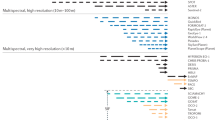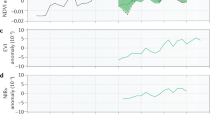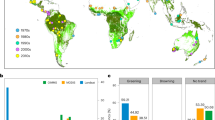Abstract
Vegetation ‘greenness’ characterized by spectral vegetation indices (VIs) is an integrative measure of vegetation leaf abundance, biochemical properties and pigment composition. Surprisingly, satellite observations reveal that several major VIs over the US Corn Belt are higher than those over the Amazon rainforest, despite the forests having a greater leaf area. This contradicting pattern underscores the pressing need to understand the underlying drivers and their impacts to prevent misinterpretations. Here we show that macroscale shadows cast by complex forest structures result in lower greenness measures compared with those cast by structurally simple and homogeneous crops. The shadow-induced contradictory pattern of VIs is inevitable because most Earth-observing satellites do not view the Earth in the solar direction and thus view shadows due to the sun–sensor geometry. The shadow impacts have important implications for the interpretation of VIs and solar-induced chlorophyll fluorescence as measures of global vegetation changes. For instance, a land-conversion process from forests to crops over the Amazon shows notable increases in VIs despite a decrease in leaf area. Our findings highlight the importance of considering shadow impacts to accurately interpret remotely sensed VIs and solar-induced chlorophyll fluorescence for assessing global vegetation and its changes.
This is a preview of subscription content, access via your institution
Access options
Access Nature and 54 other Nature Portfolio journals
Get Nature+, our best-value online-access subscription
$29.99 / 30 days
cancel any time
Subscribe to this journal
Receive 12 digital issues and online access to articles
$119.00 per year
only $9.92 per issue
Buy this article
- Purchase on Springer Link
- Instant access to full article PDF
Prices may be subject to local taxes which are calculated during checkout




Similar content being viewed by others
Data availability
The data are available through figshare56 at https://doi.org/10.6084/m9.figshare.23677407.v1.
Code availability
The source code is available through figshare57 at https://doi.org/10.6084/m9.figshare.23677260.v1.
References
Tucker, C. J. Red and photographic infrared linear combinations for monitoring vegetation. Remote Sens. Environ. 8, 127–150 (1979).
Myneni, R. B., Keeling, C., Tucker, C. J., Asrar, G. & Nemani, R. R. Increased plant growth in the northern high latitudes from 1981 to 1991. Nature 386, 698–702 (1997).
Zeng, Y. et al. Optical vegetation indices for monitoring terrestrial ecosystems globally. Nat. Rev. Earth Environ. 3, 477–493 (2022).
Piao, S. et al. Characteristics, drivers and feedbacks of global greening. Nat. Rev. Earth Environ. 1, 14–27 (2020).
Chen, J. M. et al. Vegetation structural change since 1981 significantly enhanced the terrestrial carbon sink. Nat. Commun. 10, 4259 (2019).
Zhang, H. et al. A novel red-edge spectral index for retrieving the leaf chlorophyll content. Methods Ecol. Evol. 13, 2771–2787 (2022).
Huete, A. et al. Overview of the radiometric and biophysical performance of the MODIS vegetation indices. Remote Sens. Environ. 83, 195–213 (2002).
Badgley, G., Field, C. B. & Berry, J. A. Canopy near-infrared reflectance and terrestrial photosynthesis. Sci. Adv. 3, e1602244 (2017).
Kimm, H. et al. Deriving high-spatiotemporal-resolution leaf area index for agroecosystems in the US Corn Belt using Planet Labs CubeSat and STAIR fusion data. Remote Sens. Environ. 239, 111615 (2020).
Maeda, E. E. et al. Large-scale commodity agriculture exacerbates the climatic impacts of Amazonian deforestation. Proc. Natl Acad. Sci. USA 118, e2023787118 (2021).
Bi, J. et al. Sunlight mediated seasonality in canopy structure and photosynthetic activity of Amazonian rainforests. Environ. Res. Lett. 10, 064014 (2015).
Wu, J. et al. Biological processes dominate seasonality of remotely sensed canopy greenness in an Amazon evergreen forest. New Phytol. 217, 1507–1520 (2018).
Hashimoto, H. et al. New generation geostationary satellite observations support seasonality in greenness of the Amazon evergreen forests. Nat. Commun. 12, 684 (2021).
Zhang, Y. et al. A global moderate resolution dataset of gross primary production of vegetation for 2000–2016. Sci. Data 4, 170165 (2017).
Park, T. et al. Changes in growing season duration and productivity of northern vegetation inferred from long-term remote sensing data. Environ. Res. Lett. 11, 084001 (2016).
Schaaf, C. B. et al. First operational BRDF, albedo nadir reflectance products from MODIS. Remote Sens. Environ. 83, 135–148 (2002).
Morton, D. C. et al. Amazon forests maintain consistent canopy structure and greenness during the dry season. Nature 506, 221–224 (2014).
Saleska, S. R. et al. Dry-season greening of Amazon forests. Nature 531, E4–E5 (2016).
Zeng, Y. et al. A practical approach for estimating the escape ratio of near-infrared solar-induced chlorophyll fluorescence. Remote Sens. Environ. 232, 111209 (2019).
Myers-Smith, I. H. et al. Complexity revealed in the greening of the Arctic. Nat. Clim. Change 10, 106–117 (2020).
Rautiainen, M. & Stenberg, P. Application of photon recollision probability in coniferous canopy reflectance simulations. Remote Sens. Environ. 96, 98–107 (2005).
Chen, C. et al. China and India lead in greening of the world through land-use management. Nat. Sustain. 2, 122–129 (2019).
Parker, G. G., Fitzjarrald, D. R. & Sampaio, I. C. G. Consequences of environmental heterogeneity for the photosynthetic light environment of a tropical forest. Agric. For. Meteorol. 278, 107661 (2019).
Camps-Valls, G. et al. A unified vegetation index for quantifying the terrestrial biosphere. Sci. Adv. 7, eabc7447 (2021).
Yin, G., Verger, A., Descals, A., Filella, I. & Peñuelas, J. A broadband green–red vegetation index for monitoring gross primary production phenology. J. Remote Sens. 2022, 9764982 (2022).
Breon, F.-M. & Maignan, F. A BRDF–BPDF database for the analysis of Earth target reflectances. Earth Syst. Sci. Data 9, 31–45 (2017).
Diner, D. J. et al. Multi-angle Imaging SpectroRadiometer (MISR) instrument description and experiment overview. IEEE Trans. Geosci. Remote Sens. 36, 1072–1087 (1998).
Kaufmann, R. K. et al. Effect of orbital drift and sensor changes on the time series of AVHRR vegetation index data. IEEE Trans. Geosci. Remote Sens. 38, 2584–2597 (2000).
Qi, J. et al. LESS: LargE-Scale remote sensing data and image simulation framework over heterogeneous 3D scenes. Remote Sens. Environ. 221, 695–706 (2019).
Dos-Santos, M., Keller, M. & Morton, D. LiDAR Surveys Over Selected Forest Research Sites, Brazilian Amazon, 2008–2018 (ORNL DAAC, 2019); https://doi.org/10.3334/ORNLDAAC/1644
Köhler, P., Guanter, L., Kobayashi, H., Walther, S. & Yang, W. Assessing the potential of sun-induced fluorescence and the canopy scattering coefficient to track large-scale vegetation dynamics in Amazon forests. Remote Sens. Environ. 204, 769–785 (2018).
Vancutsem, C. et al. Long-term (1990–2019) monitoring of forest cover changes in the humid tropics. Sci. Adv. 7, eabe1603 (2021).
Abera, T. A., Heiskanen, J., Pellikka, P., Rautiainen, M. & Maeda, E. E. Clarifying the role of radiative mechanisms in the spatio-temporal changes of land surface temperature across the Horn of Africa. Remote Sens. Environ. 221, 210–224 (2019).
Zheng, L. et al. Spatial, temporal, and spectral variations in albedo due to vegetation changes in China’s grasslands. ISPRS J. Photogramm. Remote Sens. 152, 1–12 (2019).
Alibakhshi, S., Naimi, B., Hovi, A., Crowther, T. W. & Rautiainen, M. Quantitative analysis of the links between forest structure and land surface albedo on a global scale. Remote Sens. Environ. 246, 111854 (2020).
Yan, H. et al. Forest greening increases land surface albedo during the main growing period between 2002 and 2019 in China. J. Geophys. Res. Atmos. 126, e2020JD033582 (2021).
Ollinger, S. V. et al. Canopy nitrogen, carbon assimilation, and albedo in temperate and boreal forests: functional relations and potential climate feedbacks. Proc. Natl Acad. Sci. USA 105, 19336–19341 (2008).
Zhang, Y. et al. Spatio-temporal convergence of maximum daily light-use efficiency based on radiation absorption by canopy chlorophyll. Geophys. Res. Lett. 45, 3508–3519 (2018).
Lin, S. et al. Multi-site assessment of the potential of fine resolution red-edge vegetation indices for estimating gross primary production. Int. J. Appl. Earth Obs. Geoinf. 113, 102978 (2022).
Xiao, X. et al. Satellite-based modeling of gross primary production in an evergreen needleleaf forest. Remote Sens. Environ. 89, 519–534 (2004).
Joiner, J. et al. Estimation of terrestrial global gross primary production (GPP) with satellite data-driven models and eddy covariance flux data. Remote Sens. 10, 1346 (2018).
Badgley, G., Anderegg, L. D., Berry, J. A. & Field, C. B. Terrestrial gross primary production: using NIRV to scale from site to globe. Glob. Change Biol. 25, 3731–3740 (2019).
Neale, C. M., Gonzalez-Dugo, M. P., Serrano-Perez, A., Campos, I. & Mateos, L. Cotton canopy reflectance under variable solar zenith angles: implications of use in evapotranspiration models. Hydrol. Process. 35, e14162 (2021).
Yebra, M., Van Dijk, A., Leuning, R., Huete, A. & Guerschman, J. P. Evaluation of optical remote sensing to estimate actual evapotranspiration and canopy conductance. Remote Sens. Environ. 129, 250–261 (2013).
Chen, J. M. & Liu, J. Evolution of evapotranspiration models using thermal and shortwave remote sensing data. Remote Sens. Environ. 237, 111594 (2020).
Chen, M. & Zhuang, Q. Evaluating aerosol direct radiative effects on global terrestrial ecosystem carbon dynamics from 2003 to 2010. Tellus B 66, 21808 (2014).
Marshak, A. et al. Earth observations from DSCOVR/EPIC instrument. Bull. Am. Meteorol. Soc. 99, 1829–1850 (2018).
Myneni, R. et al. Global products of vegetation leaf area and fraction absorbed PAR from year one of MODIS data. Remote Sens. Environ. 83, 214–231 (2002).
Friedl, M. A. et al. Global land cover mapping from MODIS: algorithms and early results. Remote Sens. Environ. 83, 287–302 (2002).
Gorelick, N. et al. Google Earth Engine: planetary-scale geospatial analysis for everyone. Remote Sens. Environ. 202, 18–27 (2017).
Köhler, P. et al. Global retrievals of solar-induced chlorophyll fluorescence with TROPOMI: first results and intersensor comparison to OCO-2. Geophys. Res. Lett. 45, 10,456–10,463 (2018).
Hao, D. et al. Estimating hourly land surface downward shortwave and photosynthetically active radiation from DSCOVR/EPIC observations. Remote Sens. Environ. 232, 111320 (2019).
Hao, D. et al. DSCOVR/EPIC-derived global hourly and daily downward shortwave and photosynthetically active radiation data at 0.1°× 0.1° resolution. Earth Syst. Sci. Data 12, 2209–2221 (2020).
Ni, X. et al. Vegetation angular signatures of equatorial forests from DSCOVR EPIC and Terra MISR observations. Front. Remote Sens. 2, 766805 (2021).
Aneece, I. P. et al. in Fundamentals, Sensor Systems, Spectral Libraries, and Data Mining for Vegetation (eds Thenkabail P. S. et al.) 251–272 (CRC Press, 2018).
Zeng, Y. The data for the NEE paper: structural complexity biases vegetation greenness measures. figshare https://doi.org/10.6084/m9.figshare.23677407.v1 (2023).
Zeng, Y. The code for the NEE paper: structural complexity biases vegetation greenness measures. figshare https://doi.org/10.6084/m9.figshare.23677260.v1 (2023).
Seyednasrollah, B. et al. Tracking vegetation phenology across diverse biomes using Version 2.0 of the PhenoCam Dataset. Sci. Data https://doi.org/10.1038/s41597-019-0229-9 (2019).
Acknowledgements
Support for this research was provided by the Office of the Vice Chancellor for Research and Graduate Education, University of Wisconsin-Madison, with funding from the Wisconsin Alumni Research Foundation. D.H. acknowledges support from the Earth System Model Development programme area, Office of Biological and Environmental Research, Office of Science, US Department of Energy, as part of the Climate Process Team projects. T.P. acknowledges support from the Earth Science Division of NASA. Y.G. acknowledges support from Universities Scientific Fund (15053347). M.C. acknowledges support from a McIntire–Stennis grant (1027576) from the National Institute of Food and Agriculture, US Department of Agriculture. We acknowledge PhenoCam for providing the site imagery at Tapajos and Mead1; the latter was a contribution of the Long-Term Agroecosystem Research network, supported by the US Department of Agriculture. We also thank G. Badgley for fruitful discussions on SIF.
Author information
Authors and Affiliations
Contributions
Y.Z., M.C., D.H. and T.P. conceptualized the study, designed the research and methodology, and wrote the initial draft of the paper. P.Z., A.H., R.M., Y.K., R.N., P.K., C.F., J.B., F.L., Y.G. and F.J. contributed to the data collection and result interpretation. J.Q., J.H., B.L. and F.J. contributed to the 3D ray-tracing model simulation and sensitivity analysis. F.L., Y.G. and F.J. drew and polished the figures. All authors reviewed and edited the paper and made substantial contributions to the improvement of the paper.
Corresponding authors
Ethics declarations
Competing interests
The authors declare no competing interests.
Peer review
Peer review information
Nature Ecology & Evolution thanks Anping Chen, Mathias Disney and Shangrong Lin for their contribution to the peer review of this work.
Additional information
Publisher’s note Springer Nature remains neutral with regard to jurisdictional claims in published maps and institutional affiliations.
Extended data
Extended Data Fig. 1 The contrasting patterns between the Corn Belt (upper circle) and Amazon rainforest (lower circle) in August during 2001–2019 at global maps.
The same as in Fig. 1, the MODIS EVI, NIRv and fesc were smaller over the Amazon rainforest than over the Corn Belt, while the MODIS LAI shows the opposite pattern. This effect is also found in the cropland in Northeast Asia, the rainforest in Southeast Asia, and the eastern forest region in North America near the Corn Belt with the same season and similar latitude.
Extended Data Fig. 2
Comparison of VIs, FPAR and SIF between the Corn Belt (upper panels) and Amazon rainforest (lower panels) in August during 2001–2019.
Extended Data Fig. 3 The relationship among LAI, FPAR, SIF and VIs over the Corn Belt and Amazon rainforest.
(a) The relationship between LAI or FPAR with EVI, NIRv, SIF/PAR and NDVI over the Corn Belt (in red) and Amazon rainforest (in blue) in August during 2001–2019. The linear slopes over the Corn Belt were at least twice as high as those over the Amazon rainforest. In each panel, the degree of point transparency represents the point density. (b) The correlation coefficient among LAI, FPAR, SIF and VIs over the Corn Belt and Amazon rainforest in August during 2001–2019. The relationship among VIs and SIF were much higher than they were compared to FPAR and LAI, especially over the Corn Belt.
Extended Data Fig. 4
Comparisons of VIs, LAI and fesc between the Corn Belt and Amazon rainforest in August of each year during 2001–2019.
Extended Data Fig. 5 The comparison of the Corn Belt (upper panels) and Amazon rainforest (lower panels) in August during the period of 2001–2019.
Additional global VI and LAI products, including MOD13 NDVI/EVI, GEOV LAI and GLASS LAI, were used for the analysis in addition to the MCD43 NDVI/EVI and MODIS LAI shown in Fig. 1. Similar to Fig. 1, the EVI values are lower over the Amazon rainforest compared to the Corn Belt, while the LAI shows the opposite pattern, with larger values observed in the Amazon rainforest.
Extended Data Fig. 6
Comparison of VIs, LAI and fesc between the Corn Belt and Amazon rainforest in August during 2001–2019 at different levels of GRVI, which was used as a proxy of canopy pigment pools.
Extended Data Fig. 7 Comparisons of VIs, LAI and fesc between the US Corn Belt (upper panels in a) and a nearby forest region in the Northeastern North America (NA, lower panels in a) in August during 2001–2019.
(b) The MODIS EVI, NIRv and fesc were lower over the forest region compared to the Corn Belt, due to the stronger shadows in view. In contrast, the MODIS LAI was higher in the forest region than in the Corn Belt. The corresponding violin plots display the quartile and mean of the target variables, and as well as their distributions. (c) Comparison of VIs, LAI and fesc between the Corn Belt and the nearby forest region in North America in August during 2001–2019 at different levels of GRVI, which was used as a proxy of canopy pigment pools. (d) Comparison of EVI between the Corn Belt and the nearby forest region in North America in August during 2001–2019 at different levels of GRVI and LAI.
Extended Data Fig. 8 The canopy structure reconstructed by the 3D ray-tracing model over the Amazon rainforest (a, 100 m × 100 m) and the corn field (b,50 m × 50 m).
The Amazon rainforest structure was extracted by the LiDAR data acquired over a site located at (E 54.99, S 3.37) in 201822. Detailed input soil-leaf-canopy parameters were as in Supplementary Table 1. Multi-angular EVI, NIRv and NDVI simulations by the 3D ray-tracing model over the Corn Belt and Amazon rainforest (c) had close values at the hotspot direction (phase angle = 0 when the solar and sensor directions coincide), while EVI and NIRv were always much higher over the Corn Belt than the Amazon rainforest at the off-hotspot directions (phase angle > 0, for example, at nadir view but the solar zenith angle is 45° for the standard MAIAC surface reflectance product). The phase angle in (c) is the angle between the solar and sensor directions. The ‘Spectrum Replaced’ represents the simulation of the corn field while the soil-leaf spectrum was replaced by the spectrum of the Amazon rainforest (c).
Extended Data Fig. 9 Sensitivity analysis by the LESS 3D ray-tracing model simulations of forest and crops with varied parameters in Supplementary Table 2, especially under the control of the same LAI.
(a) The separate simulated VIs of forest and crops. (b) The differences of simulated VIs between forest and crops. The same as the contrast in Extended Data Fig. 7d, the EVI and NIRv under the control of similar LAI (2.5 or 5) were smaller over forest than crops, especially when the LAI was relatively large at 5.
Extended Data Fig. 10
The eight deforestation locations in Fig. 4a with the land cover change from forest to crops within 2005–2015 over Amazon rainforest.
Supplementary information
Supplementary Information
Supplementary Tables 1 and 2.
Rights and permissions
Springer Nature or its licensor (e.g. a society or other partner) holds exclusive rights to this article under a publishing agreement with the author(s) or other rightsholder(s); author self-archiving of the accepted manuscript version of this article is solely governed by the terms of such publishing agreement and applicable law.
About this article
Cite this article
Zeng, Y., Hao, D., Park, T. et al. Structural complexity biases vegetation greenness measures. Nat Ecol Evol 7, 1790–1798 (2023). https://doi.org/10.1038/s41559-023-02187-6
Received:
Accepted:
Published:
Issue Date:
DOI: https://doi.org/10.1038/s41559-023-02187-6
This article is cited by
-
A 30-m annual corn residue coverage dataset from 2013 to 2021 in Northeast China
Scientific Data (2024)
-
Physical–chemical characterization of Amazonian dark earth as influenced by tropical fruticulture in western Brazil’s Legal Amazon
Journal of Soils and Sediments (2024)



